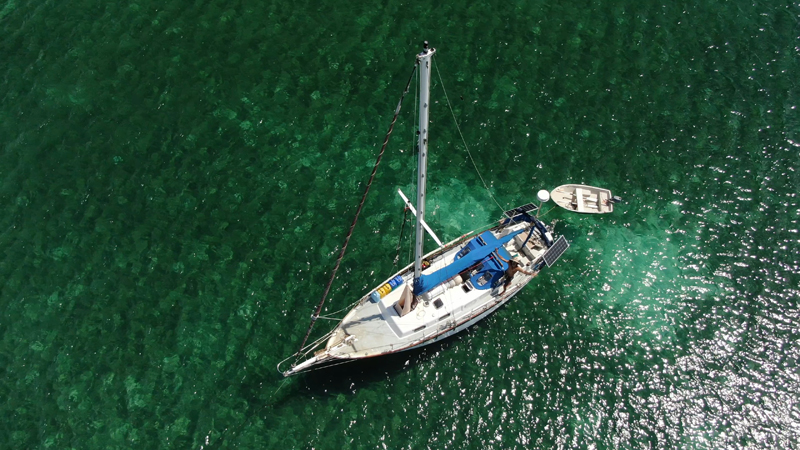Anchoring tips for Sailors
Whether you are cruising the Chesapeake Bay or chartering in an exotic locale, anchoring for afternoon or overnight can be one of the joys of sailing. Here are 10+ common-sense tips to help ensure you and your sailing crew enjoy your time on the hook.

Anchor line: rode and scope
Rode is a term that sailors use for the combination of the anchor chain and the anchor rope. Scope is another common anchoring term. Scope calcuations are based on the vertical distance from the sea bed to the point where the anchor line comes aboard and cleats to the deck.
How much anchor line do you need? The general recommendation is to use a scope of 7:1, meaning that for every foot of water depth, you should use seven feet of rode.
Captain Rick Franke, and experienced Chesapeake sailor, says, “When anchoring, remember to let out enough line (scope) to ensure your anchor will hold. Dragging anchor through an anchorage will definitely make you unpopular! Also try not to anchor too close to other boats.” Some suggest a three-boat-length distance from other boats.
Do your homework
Before you choose your anchorage, do some homework, so you know what you're getting into. Will the bottom be muddy? Sandy? Rocky? Is there are narrow channel to the anchorage? How protected from wind and waves is the area? Are mooring balls available? Is this area infamous for boats dragging anchor?
Check local cruising guides, charts, and sailor discussion forums for information. Electronics such as a depth finder can be of much assistance.
Communication
Sometimes it can be challening to communicate from the bow to the helm, whether it's noise from wind in the rigging or simply the distance from one end of the boat to the other. The views from the bow and cockpit can be different. Shouting between the pointy end and the helm tends to up tension levels, even if no one is angry or frustrated. And if you're arriving late, no one else in the anchorage wants to hear your maneuvering communicaitons, even when all is going smoothly. To help with all of this, many cruisers swear by headsets. They're so popular that many sailing couples refer to them as 'marriage savers.'
Proper use of lights
Captain Franke notes the proper use of lights at dusk and after dark: “Running lights should be off, and a single white anchor light on, while the boat is at anchor. As soon as the anchor comes up, the running lights should be on. Doing this correctly lets other boaters know if you are moving or not. Use a search light or spot light sparingly, and keep it aimed low and avoid shining it directly at other boat operators. It takes most people’s eyes more than a half hour to become adjusted to the dark. One split second flash of a spot light in the eyes can destroy that night vision.”
Safety
Kids and poor swimmers should wear lifejackets at all times.
Monitor Channel 16 on your marine radio. USCG broadcasts safety messages and storm warnings on channel 22 after an announcement on 16, and there are dedicated weather band channels for continuous marine forecasts.
Franke says, “Give commercial vessels, such as water taxis and tour boats, room to maneuver. They are often larger and can be unwieldy in close quarters. Use common sense and courtesy. Remember that you have a responsibility to avoid a collision, regardless of who has the right of way. Keep your speed down, keep a sharp lookout, and have a non-drinking designated operator at the helm.”

10 Tips for Anchoring
- The general recommendation is to use a scope of 7:1.
- Know what the bottom is like: sandy, muddy, rocky?
- Have a chart with you to monitor water depth and entrance channels.
- While your boat is at anchor at night, running lights should be off and a single white anchor light on. As soon as the anchor comes up, the running lights should be on.
- Use a spotlight sparingly and keep it aimed low. Avoid shining it directly at other boat operators or anchored boats.
- Try not to anchor too close to other boats, and make sure you’ve let out enough line to ensure your anchor will hold. Dragging anchor through an anchorage will make you unpopular and could be dangerous when everyone is belowdecks sleeping.
- Children and poor swimmers should wear a lifejacket at all times.
- Give commercial vessels, such as water taxis and tour boats, room to maneuver.
- Keep your speed down when approaching the anchorage.
- Keep voices and music at a low decibel if you're arriving late at night.




